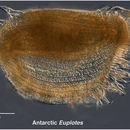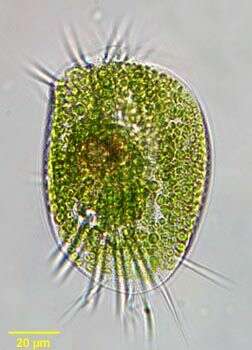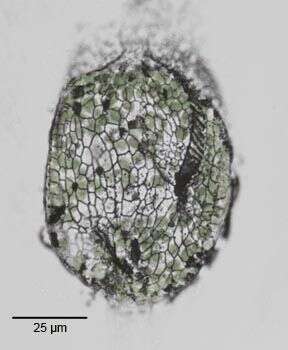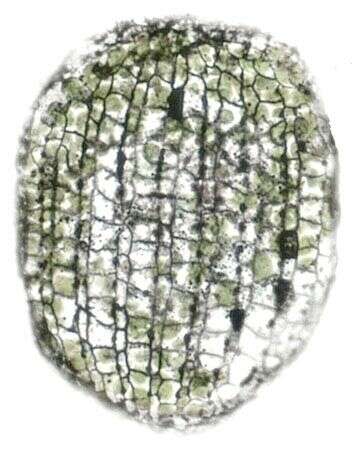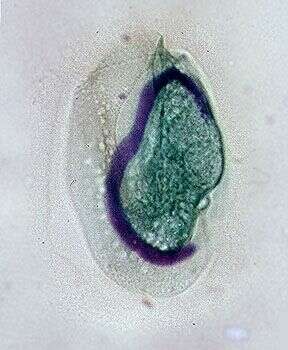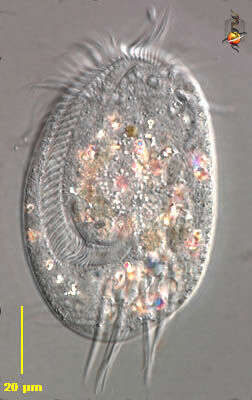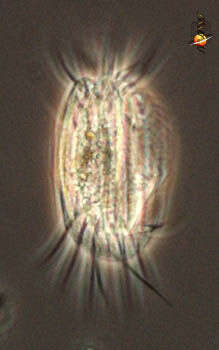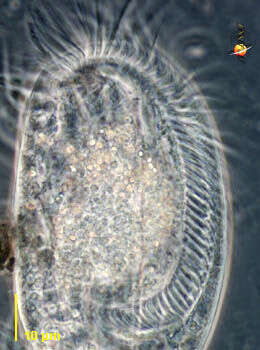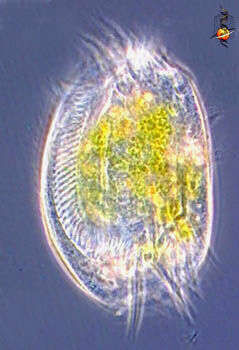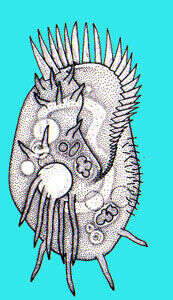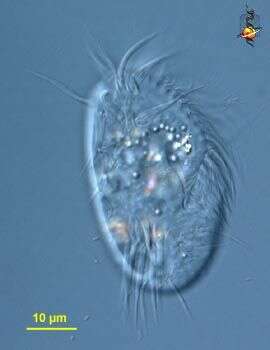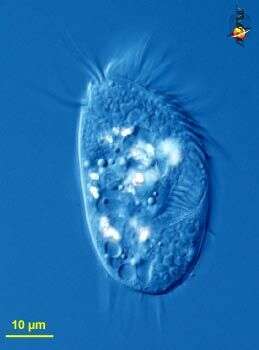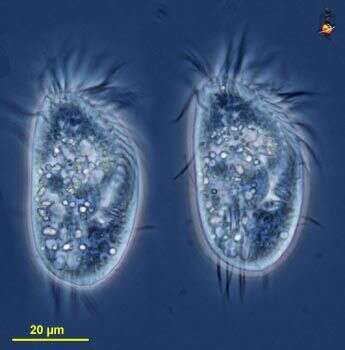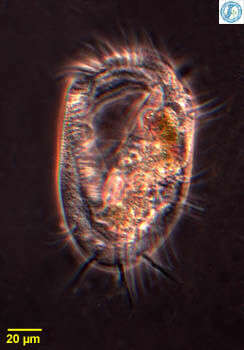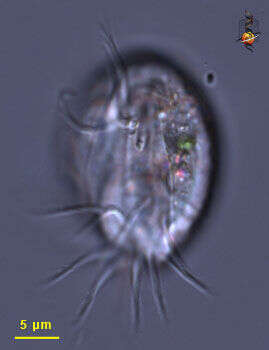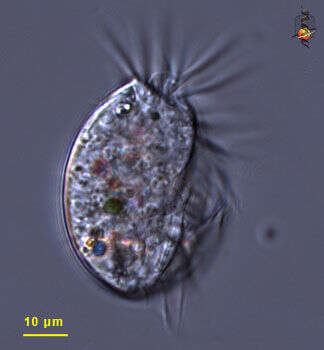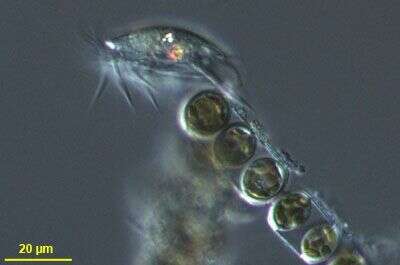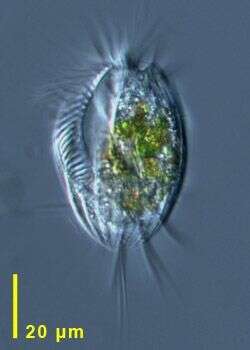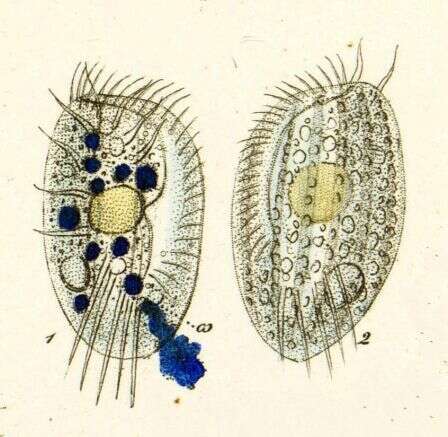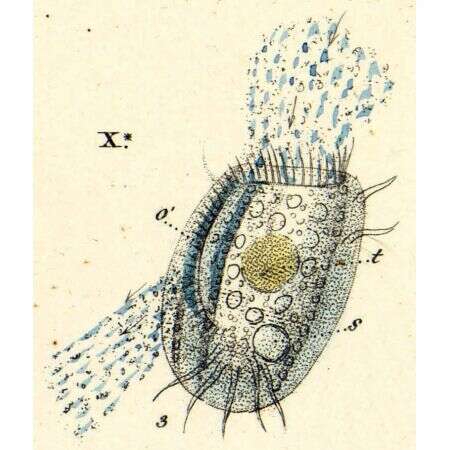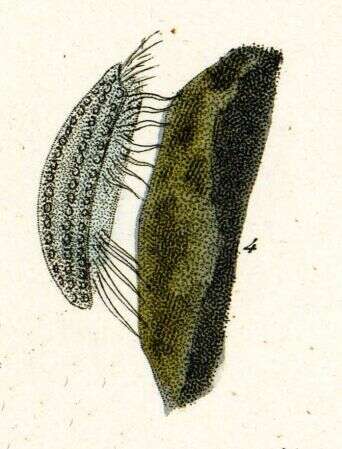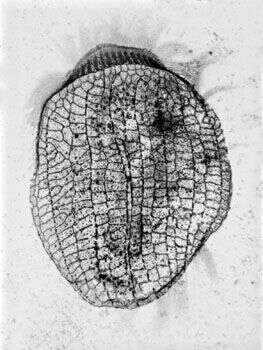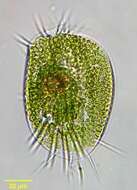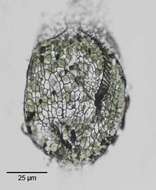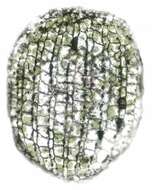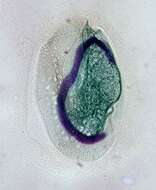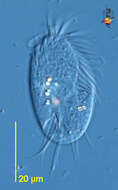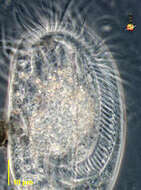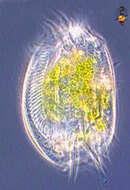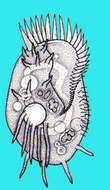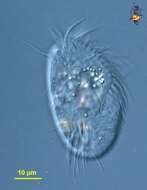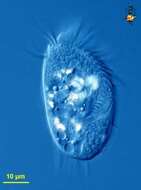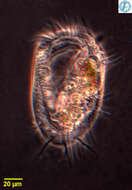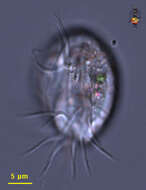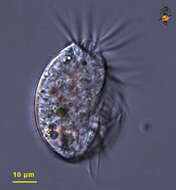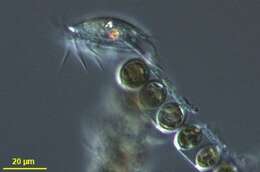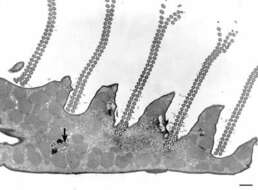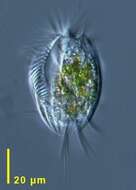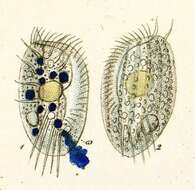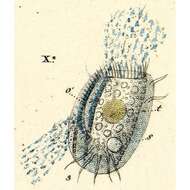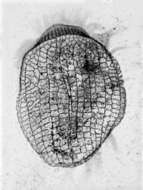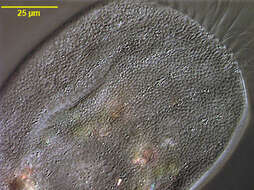-
in vivo portrait of Euplotes daidaleos (Diller, Kounaris, 1966) this species in the common and widespread genus of hypotrich ciliates has endosymbiotic green algae. From freshwater pond near Boise, Idaho.Brightfield.
-
Ventral silverline system of Euplotes daidaleos (Diller, Kounaris, 1966) this species in the common and widespread genus of hypotrich ciliates has endosymbiotic green algae.The adoral zone of membranelles is seen to the viewer's right.The positions of the cirri are indicated by the large black spots.Stained by the dry silver nitrate technique (see Foissner, W. Europ. J. Protistol., 27:313-330;1991) From freshwater pond near Boise Idaho.June 2005.Brightfield.
-
Dorsal silverline system of Euplotes daidaleos (Diller, Kounaris, 1966) this species in the common and widespread genus of hypotrich ciliates has endosymbiotic green algae of the chlorella type (still visible in this stained specimen).The silverline system of this species is the "double-patella" type. Stained by the dry silver nitrate technique (see Foissner, W. Europ. J. Protistol., 27:313-330;1991) From freshwater pond near Boise Idaho.June 2005.Brightfield.
-
Feulgen stained fixed cell, the stain colours the nuclei purple. The large curving structure is the macronucleus, and a small round micronucleus is located upper left.
-
Euplotes (you-ploe-tees) a hypotrich ciliate, with an anterior adoral zone of membranelles forming a collar and lapel leading down to the cytostome which is midway down the cell and on the ventral side. It is a hypotrich ciliate and uses cirri (aggregates of ciliate, sometimes as many as 50 or more) to walk against the substrate. Identification is approximate as the full identification requires that cells be silver-stained and the location of each cirrus be mapped out. DIfferential interference contrast.
-
Euplotes (you-p-low-tees) is a hypotrich ciliate. The hypotrichs form part of the spirotrichs, and most have a large adoral zone of membranelles curving around the front of the cells and terminating at the cytostome on the ventral surface. They are called hypotrichs because the cilia that are used for locomotion are located mostly on the ventral side of the cilia. The cilia are clustered into aggregates called cirri. Euplotids feed on suspended particles such as bacteria and algae. Common. Differential interference contrast.
-
Euplotes (you-p-low-tees) is a hypotrich ciliate. The hypotrichs form part of the spirotrichs, and most have a large adoral zone of membranelles curving around the front of the cells and terminating at the cytostome on the ventral surface. They are called hypotrichs because the cilia that are used for locomotion are located mostly on the ventral side of the cilia. The cilia are clustered into aggregates called cirri. They are clearly evident in this image of the dorsal side of the cell. Euplotids feed on suspended particles such as bacteria and algae. Common. Phase contrast.
-
Euplotes (you-p-low-tees) is a hypotrich ciliate. The hypotrichs form part of the spirotrichs, and most have a large adoral zone of membranelles curving around the front of the cells and terminating at the cytostome on the ventral surface. They are called hypotrichs because the cilia that are used for locomotion are located mostly on the ventral side of the cilia. The cilia are clustered into aggregates called cirri. This image illustrates the adoral zone of membranelles. Phase contrast.
-
Euplotes (you-p-low-tees) is a hypotrich ciliate. The hypotrichs form part of the spirotrichs, and most have a large adoral zone of membranelles curving around the front of the cells and terminating at the cytostome on the ventral surface. They are called hypotrichs because the cilia that are used for locomotion are located mostly on the ventral side of the cilia. The cilia are clustered into aggregates called cirri. Euplotids feed on suspended particles such as bacteria and algae. Common. Phase contrast.
-
-
Euplotes (you-ploe-tees) is a hypotrich ciliate. There is an adoral zone of membranelles leading from the front of the cell to the mouth (where food vacuoles are formed) on the ventral side of the body. Hypotrichs use clumps of cilia called cirri to move, and this image is focussed on the cirri which arise from the ventral side of the cell. DIfferential interference microscopy.
-
Euplotes (you-ploe-tees) is a hypotrich ciliate. There is an adoral zone of membranelles leading from the front of the cell to the mouth (where food vacuoles are formed) on the ventral side of the body. Membranelles are paddles formed by clusters of cilia which adhere to each other (at this size, water is viscous and acts like a glue holding cilia together). DIfferential interference microscopy.
-
Euplotes (you-ploe-tees) is a hypotrich ciliate. There is an adoral zone of membranelles leading from the front of the cell to the mouth (where food vacuoles are formed) on the ventral side of the body. Membranelles are paddles formed by clusters of cilia which adhere to each other (at this size, water is viscous and acts like a glue holding cilia together). Hypotrichs use clumps of cilia called cirri to move. The two images (of the same cell) are taken at slightly different focal levels. Phase contrast microscopy.
-
Euplotes, common hypotrich ciliate. There is an adoral zone of membranelles extending around the front of the cell and this is used to acquire bacteria and small protists as food. Euplotes uses cirri - collections of cilia - to walk over the substrate. From Lake Donghu, China. Phase contrast micrograph.
-
Image of ventral side of this ciliate. the extensions are the cirri - bundles of tightly packed cilia. They are only on the ventral size and it is from this characteristic that the hypotrich (under-threads) get their name. The cirri are used to gain purchase against non liquid substrate, allowing hyptorichs to crawl and walk over the substrate. Differential interference contrast optics.
-
The optical section passes through the middle of the cell. The course of the adoral zone of membranelles (AZM) is from slightly right of centre of the anterior apex of the cell, across the top of the cell and down the left side to the mouth. Differential interference optics.
-
This Euplotes is 'standing' on the end of a diatom chain, hanging on by its cirri, and with the feeding adoral zone of membranelles extending away from the substrate to capture food.
-
The membranelles of the AZM extending from the ventral side of the oral cavity are largely composed of 2 rows of cilia. A dikinetid (arrow) of the somatic surface is also present. This dikinetid also has pigment vesicles containing electron opaque material close by. EM taken on 7/24/67 by R. Allen with Philips 200 TEM. Neg. 4,500X. Bar = 1 micron.
This image is available in Richard Allen's collection.
-
This Euplotes was in Sample 2 taken adjacent to Tvärminne Zoological Station, coastal, algal material 3rd April 2012. A good sharp picture, best images not too large. Usable.
-
-
-
-
Dorsal silverline system or argyrome of the large hypotrich ciliate, Euplotes eurystomus (Wrześniowski, 1870). The silverline system of each of the many species of Euplotes belongs to one of five distinctive patterns. E. eurystomus is characterized by the "double-eurystomus type" seen in this image. The anterior portion of the adoral zone of membranelles is supported on a pellicular projection or collar (seen here).Stained by the dry silver nitrate method (see Foissner, W.Europ. J. Protistol.27,313-330;1991).Collected from a freshwater aquaculture pond near Boise, Idaho. Brightfield.
-
Dorsal surfacace of the large hypotrich ciliate, Euplotes eurystomus (Wrześniowski, 1870). The pellicle is colorless and inflexible. There are 9 - 11, (usually 10) rows of dorsal bristles in longitudinal furrows. These dorsal bristle complexes have a complicated structure consisting of dikinetids at the base of a shallow pellicular pit with only the anterior kinetid bearing a bristle. A rosette of cortical ampullae resembling mucocysts radiates from each complex (visible in this image). These dorsal bristles are probably not locomotary but may have a sensory function. Collected from a freshwater aquaculture pond near Boise, Idaho. DIC.

